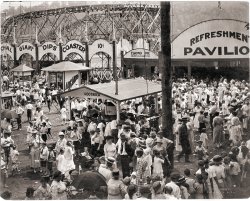
MAY CONTAIN NUTS

Search Shorpy
SHORPY ART

Framed or unframed, desk size to sofa size, printed by us in Arizona and Alabama since 2007. Explore now.
Join and Share
Ad-Free Shorpy
Shorpy is funded by you. Patreon contributors get an ad-free experience.
Learn more.

Recent comments
- Alas, hidden from view
- Exclusive pump
- Details, Details
- What's that building to the left of the tower?
- Coal Barges
- Bromo-Seltzer
- Inner harbor
- The Basin
- What a headache!
- Giant stepladder?
- Baldwin 62303
- Baldwin VO-1000
- Cold
- No expense spared
- Tough Guys
- Lost in Toyland
- And without gloves
- If I were a blindfolded time traveler
- Smoke Consumer Also Cooks
- Oh that stove!
- Possibly still there?
- What?!?
- $100 Reward
- Freeze Frame
- Texas Flyer wanted
- Just a Year Too Soon
- WWII -- Replacing men with women at the railroad crossing.
- Yes, Icing
- You kids drive me nuts!
- NOT An Easy Job
Member Photos
The Shorpy
Print Emporium
Print Emporium
Search Shorpy
Search results -- 30 results per page
- Pig Out: 1941
- July 1941. "Greased pig race, Fourth of July. Vale, Oregon." 35mm acetate negative by Russell Lee for the ... Posted by Dave - 09/23/2020 - 12:18pm -
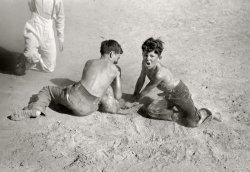
- Trading Shots: 1941
- July 1941. "Boys on the Fourth of July. State College, Pennsylvania." 35mm nitrate negative by Edwin ... Posted by Dave - 12/15/2016 - 8:10pm -
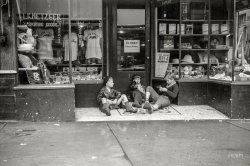
- Young America: 1941
- 1941. "Kids' race at the Fourth of July celebration in Vale, Oregon." Acetate negative by Russell Lee ... Posted by Dave - 10/18/2018 - 11:54am -
![Young America: 1941 1941. "Kids' race at the Fourth of July celebration in Vale, Oregon." Acetate negative by Russell Lee for the Farm Security Administration. View full size.
Winners! Shoeless is best! If I recall my vintage catalog research well, shoes at the time mostly came with leather soles, in addition to leather uppers. With certain exceptions, like boots for barn wear or inclement weather, which were of course rubber. Leather soled shoes would be much too slick to run in, when what you're running on is dry dirt, therefore, stocking feet - for which you'll certainly get a scolding when your mother finds the condition of the "soles" of your socks! - or better yet, bare feet, are surely the way to go!
[Another exception would be the rubber-soled sneakers worn by zillions of boys. - Dave]
WinnersBarefoot seems to be the way to win. Stocking feet seems to be doing well also. Who needs shoes!
Nice to see that the race is one class and not split between boys and girls or between ages. Of course, don't know if they have separate prizes but at least it is one race.
Fit bunchNot a lot of body fat in the group.
Chalk one up for the girls.They seem to be holding their own among all the boys.
Boy on leftNever run a race without your Stetson on.
(The Gallery, July 4, Kids, Russell Lee, Small Towns, Sports)](https://www.shorpy.com/files/images/SHORPY-8c01698a.thumbnail.jpg)
- Soapbox Derby: 1940
- 1940. "Start of soapbox auto race at Fourth of July celebration in Salisbury, Maryland." 35mm nitrate negative by ... Posted by Dave - 08/20/2012 - 6:19pm -
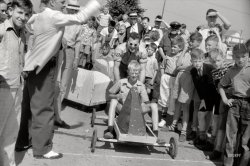
- Little Squirt: 1941
- July 1941. "Fun at the water fountain. Fourth of July picnic in Vale, Oregon." Photo by Russell Lee for the Farm ... Posted by Dave - 07/07/2014 - 4:00am -
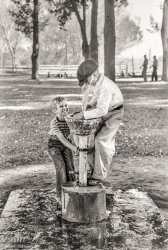
- Coffee Run: 1941
- ... 1941. "Free coffee served at the picnic grounds on the Fourth of July at Vale, Oregon." 35mm nitrate negative by Russell Lee for the ... Posted by Dave - 07/06/2014 - 10:58am -
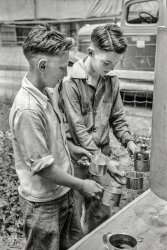
- Summer Games: 1938
- ... July 1938. Ashville, Ohio. "Wrestling matches at the Fourth of July celebration." View full size. 35mm nitrate negative by Ben ... Posted by Dave - 06/27/2009 - 7:20am -
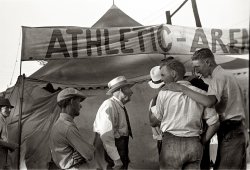
- Hill House: 1936
- ... "Sharecroppers' families gathering needs for their Fourth of July celebration, whites and blacks together." View full size. ... Posted by Dave - 09/07/2018 - 11:55am -
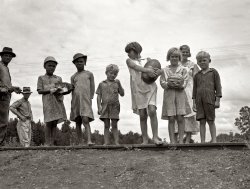
- A Fair to Remember: 1941
- ... July 1941. "Carnival attractions in Vale, Oregon, on the Fourth of July." Acetate negative by Russell Lee for the Farm Security ... Posted by Dave - 02/22/2019 - 1:09pm -
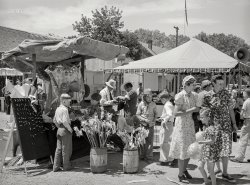
- Too Much Excitement: 1941
- ... grounds in Vale, Oregon. "Interlude, after watching the Fourth of July parade." View full size. 35mm nitrate negative by Russell ... Posted by Dave - 01/09/2008 - 9:14pm -
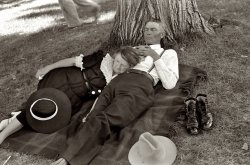
- Pulling Together: 1941
- July 1941. "Boys' tug of war, Fourth of July celebration. Vale, Oregon." 35mm acetate negative by Russell Lee ... Posted by Dave - 09/24/2020 - 11:21am -
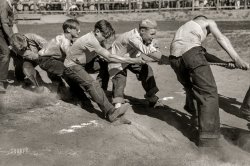
- Mass. Transit: 1912
- ... it very rarely goes up these days -- mostly only on the Fourth of July when yachts come in from the harbor to watch the fireworks.
... Posted by Dave - 08/15/2012 - 2:39pm -
![Mass. Transit: 1912 Boston circa 1912. "East Cambridge Bridge." A visual compendium of ways to get from here to there. 8x10 glass negative, Detroit Publishing Co. View full size.
Not much has changedThe trolley track viaduct is still there. The building on the left with the tower still exists. It overlooks the Charles River dam. It still has a drawbridge over the connection lock between the river and Boston Harbor. Farther up on the left past the tower is now the location of the Boston Museum of Science.
Beauty lost to timeView Larger Map
Sensational!Remarkably, much of what is depicted in this photograph, which looks from Boston back across the Charles River to Cambridge, remains in place. Most prominently, the poured concrete viaduct for the trolley (today, referred to as the Green Line) running along the right side of the photo, is still there. I have often looked at the "1910" date engraved on the arched pediment above the column at the far right, and wondered what this part of town must have looked like when this structure was new. There is currently a drawbridge in the location where the police officer is standing in the middle of the road, in order to let sail boats get through from the Charles River (to the left) out to the Boston Harbor (to the right). The drawbridge is currently being rebuilt, and this section of road is actually closed for traffic for the next several weeks. The buildings on the left are still there as well. The tower is used (I believe) to control the drawbridge, and the lower building serves as a State Police station. A few weeks ago, a car was passing underneath the archway at the far right of the photograph, and a large chunk of concrete fell from above and shattered the driver's rear windshield. The whole structure still has a wonderful look to it, but it does need some attention.
Bridge over the River CharlesI was surprised to see that the arches of this bridge were originally much narrower than they are today. (Although you can see the 1910 date has been retained.) Trolleys still run on that bridge, although it's now the only section left of a much longer elevated track that was mostly put underground during the Big Dig. There is also a drawbridge on the roadway now for boats to pass through, although it very rarely goes up these days -- mostly only on the Fourth of July when yachts come in from the harbor to watch the fireworks.
The building on the left is now a State Police outpost (perhaps it was then, too.) The Museum of Science now occupies the open space behind it.
Five out of sevenpossible methods of transportation shown here. Steam powered
rail, electric trolley, horse-drawn vehicles, motorized vehicles, and walking! Surprisingly, I couldn't spot anyone on a bicycle, nor could I see any boats in the water.
[Let us not forget the aeroplane. - Dave]
"New" HistoryHow cool it must have been to witness a construction project of this scope knowing that there probably isn't another of its type anywhere nearby. It reminds me of seeing I-75 south of Detroit being built at the end of my street in the mid 1960's where there was never a freeway before.
101 years and still on the moveThe location is in Boston, at the old Charles River Dam, which is visible as an earth rampart at the left, behind the tower with the weathervane. The trolley viaduct is in current use as part of the MBTA Green Line service. At the viaduct's end, you can see the still-existing ramp down across the roadway to Lechmere station.
In the roadway below, currently known as Monsignor O'Brien Highway and Route 28, it looks like they haven't yet installed the Craigie Drawbridge (though they've installed the traffic control gates for the streetcar, the sidewalks look like they're still solid instead of part of a drawbridge). Also interesting is the high drawbridge built into the trolley viaduct, to accommodate sailboats entering the Charles River.
The Metropolitan District Commission building on the left (which now houses state police) has the control tower with the weathervane on top. The viaduct drawbridge is no longer operational (but the ironwork is still there), and the one in the roadway is being rebuilt right now, in a project running November 2010 through April 2011.
The two buildings at the left edge of the photo, just in front of Wellington-Wildwood Coal, are an MDC stable and boathouse. The stable is now used for work trucks by the Dept. of Conservation and Recreation, which is the renamed MDC, and the boathouse at far left is empty and deteriorating. The view of these buildings would now be blocked by the Museum of Science and its garage.
Behind the coal company building and a little to the right is the square tower (with peaked roof) of the Clerk of Courts building in Cambridge, with the main courthouse next door not visible.
Everything to the right of the viaduct is gone and changed, though there's still a major railroad crossing there for traffic to North Station.
The polesThe trolley viaduct opened in June 1912. The draw in the Cragie bridge is there, it is just hard to see. Those poles in the middle of the road are to lift the trolley wire when the bridge opens, and to realign it when span closes.
(The Gallery, Boats & Bridges, Boston, DPC, Railroads, Streetcars)](https://www.shorpy.com/files/images/4a24492a.thumbnail.jpg)
- Joyride: 1941
- ... getting on the ferris wheel, one of the attractions at the Fourth of July celebration at Vale, Oregon." Medium format acetate negative by ... Posted by Dave - 10/30/2018 - 5:27pm -
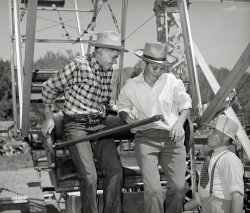
- Liberté, Fraternité: 1918
- ... at Gare d'Ivry, Paris, showing decorations in honor of the Fourth of July, which was celebrated by the French as well as by the ... Posted by Dave - 07/14/2017 - 11:26am -
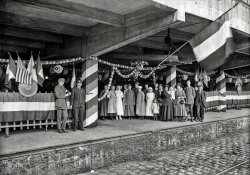
- New Kenmore: 1906
- ... Stars and Stripes It is either Flag Day or around the Fourth of July. I count about 39 flags. Great photo!
Still There And ... Posted by Dave - 08/15/2012 - 3:52pm -
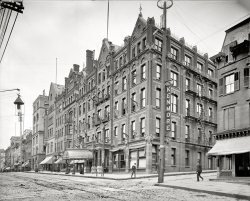
- Red, White & Brew: 1943
- ... tear down anything. I once spent a very uncomfortable Fourth of July in Palacios at a ramshackle beach hotel that ought to have ... Posted by Dave - 04/02/2014 - 6:48pm -
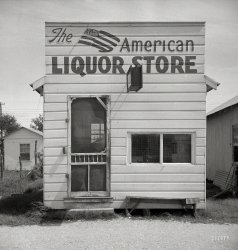
- My Little Piggy: 1941
- 1941. "Boy who caught the greased pig at the Fourth of July celebration at Vale, Oregon. Says he's going to join the 4-H ... Posted by Dave - 10/18/2018 - 11:53am -
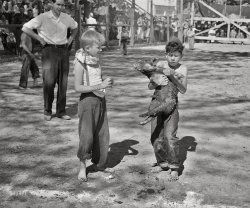
- Li'l Darlin's: 1955
- ... remember my male relatives NOT wearing ties to were the Fourth of July picnics.
(ShorpyBlog, Member Gallery, Thanksgiving, ... Posted by tterrace - 09/20/2011 - 1:12pm -
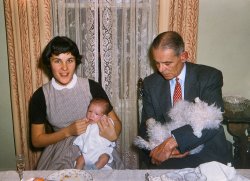
- Be Prepared: 1918
- ... Washington, D.C., circa 1918. "Robert Hall, group." Happy Fourth of July from Shorpy! 8x10 inch glass negative, Harris & Ewing ... Posted by Dave - 08/07/2012 - 3:18am -
![Be Prepared: 1918 Washington, D.C., circa 1918. "Robert Hall, group." Happy Fourth of July from Shorpy! 8x10 inch glass negative, Harris & Ewing Collection. View full size.
Hue and EyeGreat colorization. It's funny how all it takes is a little color to make the picture look like it could have been taken this year. Thanks!
Next: rubbing two sticks togetherFig. 38: Allegorical tableau: "Youth Instructing Liberty in Preparedness in Battle and Wilderness Footwear." Study by Mr. Saint-Gaudens for obverse of pattern $20 gold piece, rejected by Mint Director as inappropriately suggestive.
Update: Well, I was close.
Color Me BaadHaven't colorized a photo in a while and felt that this image would provide a wonderful canvas. Click to enlarge!
Third Liberty LoanThey seem to be modeling Joseph Leyendecker's BSA Liberty Loan poster for war bonds.
[This is a good example of the effectiveness of illustration as compared to photography. Or maybe it's just a lesson about the importance of casting. - Dave]
(The Gallery, Boy Scouts, D.C., Harris + Ewing, Patriotic, WWI)](https://www.shorpy.com/files/images/19100a.thumbnail.jpg)
- Bed Race: 1919
- 1919. "Fourth of July. Scenes in celebration at Walter Reed Hospital." The ... Posted by Dave - 08/05/2012 - 7:58pm -
![Bed Race: 1919 1919. "Fourth of July. Scenes in celebration at Walter Reed Hospital." The ever-popular Competitive Napping event, maybe. Or would this demonstration have another purpose? Harris & Ewing Collection. View full size.
Missing BitsWell they are all missing at least part of an arm. So I'd guess it's a race to see who can get dressed the most quickly as a demonstration how well they've done in their rehab.
One two three.I see a missing arm and two missing hands (three if you want to get technical). Good luck, boys, and thanks.
Competitive DressingThe Washington Post fails to mention any one-handed dressing races but notes that other competitions of the day included "an artificial leg walk, a thirty-yard hop and a crutch race."
PutteesI'd love to see them try to wrap those puttees you see rolled up next to their shoes.
Here's a How-to.
Puttees IIWell, the guy whose arm is completely gone doesn't have any puttees by his shoes. Perhaps with most of an arm to hold things in place, the puttee is considered doable.
And what about the middle guy's right leg? Did he get his calf muscle shot off, or did he have polio?
[Neither. The blanket is hiding it. - Dave]
ContestThey are racing to see who can be first to go from bedded down to dressed and ready to go. My money is on the guy in the middle!
Puttees in your handAs a history teacher, I wear a WWI uniform three or four times a year. Puttees are fun enough when you have two hands -- this is ridiculous!
(The Gallery, D.C., Harris + Ewing, WWI)](https://www.shorpy.com/files/images/12423a_0.thumbnail.jpg)
- Flag Day: 1915
- ... to be a very big patriotic holiday, celebrated like the Fourth of July. Perhaps it faded away because it is on June 14th and that is ... Posted by Dave - 09/03/2012 - 6:50pm -
![Flag Day: 1915 "Post Office, Washington. Flag Day 1915." View full size. National Photo Co.
The Glass Ceiling. And Glass Floor?Interesting setup, seems to be one huge skylight under another. Wonder why they did it that way.
Good DesignSkylights? The better to see you with, my dear! Also, with the open atrium (as it is called now) and exterior windows that could actually be opened (something rarely seen in today's buildngs) the circulation of air is enhanced. Think of those hot and humid days in DC without air conditioning.
[The question was, why is the "floor" also a skylight. - Dave]
Glass Floor Perhaps this is where the term "Daylight Basement" came from.
From the GSA website:
http://www.gsa.gov/Portal/gsa/ep/contentView.do?P=PMHP&contentId=19389&c...
"The most remarkable feature inside is the nine-story light court topped by an enormous skylight that floods the interior with natural light. When it was built, the room was the largest, uninterrupted interior space in Washington."
Are you sure......that the whole floor is glass? It looks to me like there are skylights around the exterior but the middle looks, to me at least; like bricks or maybe tiles. The skylights were to add daylight to a drab concrete basement. Having lived in DC all my life and worked in several government buildings I can speak for the dull grey "dungeon" feel of most of the basements of government buldings. - Malik
[Click below to enlarge. - Dave]
I'm flooredPerhaps I'm not looking at the right floor, but why is it assumed that the floor is glass? It appears to me that it could certainly be tile or stone (and when I've visited the OPOB on several occasions I've not noticed anything too unusual about the floor, like it being glass).
[Examine it carefully, along with the next photo down. - Dave]
Floor to CeilingThe questionable floor is also the ceiling of the basement, which housed the city's post office. The rest of the building consisted of offices.
Hardly acknowledgedFlag Day used to be a very big patriotic holiday, celebrated like the Fourth of July. Perhaps it faded away because it is on June 14th and that is very close to Independence Day and not far from Memorial Day, both of which commemmorate similar patriotism. I wonder how many people today are even aware of Flag Day or its date. You can see by the extensive decorations that it used to be one very big deal. And the beat goes on.
Call that progress?I worked in this building in the 1980s, after its renovation, and the main things I remember were noise, and terrible ventilation.
(The Gallery, D.C., Natl Photo, Patriotic)](https://www.shorpy.com/files/images/32210u.thumbnail.jpg)
- Earthworks: 1864
- ... Georgia. I spent nearly every childhood family picnic and Fourth of July here. It looks very different now.
Earthworks The ... Posted by Dave - 08/15/2011 - 8:25pm -
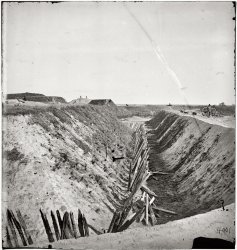
- Baker Bikers: 1941
- July 1941. "Motorcycle racers, Fourth of July, Vale, Oregon." Members of the Baker Motorcycle Club, last ... Posted by Dave - 09/21/2020 - 11:39am -
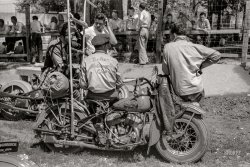
- Electric George: 1916
- ... Shorpy in the first page.
Timely Somehow, the Fourth of July springs to mind. Not sure why, but there's something about this ... Posted by Dave - 09/04/2012 - 12:05pm -
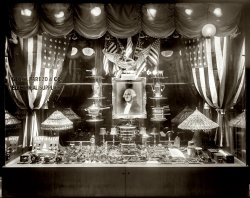
- Molalla Buckeroo: 1936
- ... 4, 1936. "Warm Springs Indian at Molalla Buckeroo," the Fourth of July rodeo in Molalla, Oregon. Medium-format nitrate negative by ... Posted by Dave - 10/27/2019 - 3:28pm -
![Molalla Buckeroo: 1936 July 4, 1936. "Warm Springs Indian at Molalla Buckeroo," the Fourth of July rodeo in Molalla, Oregon. Medium-format nitrate negative by Arthur Rothstein for the Resettlement Administration. View full size.
The final humiliationThe classic features of this Native American call to mind the profile on the buffalo nickel (1913-1938) by sculptor James Earle Fraser.
[The resemblance is rather striking, although according to Fraser the depiction is a composite rather than a specific individual. - tterrace]
(The Gallery, Arthur Rothstein, Native Americans)](https://www.shorpy.com/files/images/SHORPY_8b28018a.thumbnail.jpg)
- Red, White, Blue: 1963
- ... against a backdrop of snow white and sky blue. Happy Fourth of July from Shorpy! View full size.
Not a Marketing Department ... Posted by Dave - 07/04/2021 - 2:05pm -
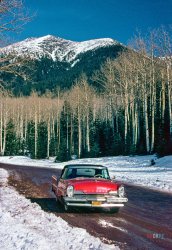
- Utopian Picnic: 1936
- ... July 1936. "Hillhouse, Mississippi. Girls with food for Fourth of July celebration at Delta Cooperative Farm settled by evicted ... Posted by Dave - 09/07/2018 - 11:57am -
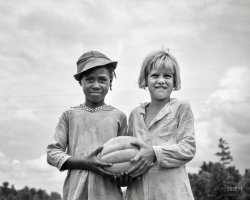
- Luna Park: 1915
- ... New York. This photo is believed to have been taken on the Fourth of July, due to the dress of some of the people (like Uncle Sam). The ... Posted by wvsky - 09/20/2011 - 10:27pm -
